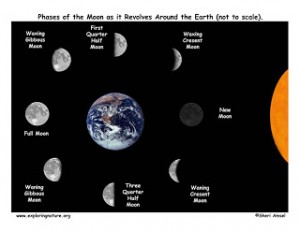 I’m not afraid to admit that I am a big science nerd; especially when it comes to astronomy! I have been at High Trails for more than a season now, and I have to say that my favorite class that I am privileged to teach is definitely Astronomy.
I’m not afraid to admit that I am a big science nerd; especially when it comes to astronomy! I have been at High Trails for more than a season now, and I have to say that my favorite class that I am privileged to teach is definitely Astronomy.
Astronomy classes are spread out over a two-night period and topics covered are: Stars, Planets, and Satellites. We even get to look through our telescope on one of the nights! While I like to think that I know plenty about the cosmos, there has been a reoccurring question that pops up almost every lesson that I have been struggling to give a good answer to, “What is the difference between a new moon and an eclipse?”
What is the difference between a new moon and an eclipse?
After some thorough research, I realized this is a loaded question that needs to be broken down and explained in a couple different segments. In order to understand the difference, one must understand that our satellite, Moon, is a rocky celestial body that orbits our Earth. The moon does not generate its own light, and is visible due to the reflection of sunlight bouncing off of its surface.
 It takes the moon 29.5 days to make one complete orbit around the Earth. While it orbits our Earth, the moon’s positioning toward the sun changes, which is what ultimately causes the phases of the moon. A new moon occurs when the moon is positioned between the sun and Earth. No sunlight is being reflected off of the moon, so we are not able to see it. A full moon occurs when the moon is positioned on the other side of Earth. The sun, Earth, and Moon are lined up, so that the moon is fully illuminated by the sun.
It takes the moon 29.5 days to make one complete orbit around the Earth. While it orbits our Earth, the moon’s positioning toward the sun changes, which is what ultimately causes the phases of the moon. A new moon occurs when the moon is positioned between the sun and Earth. No sunlight is being reflected off of the moon, so we are not able to see it. A full moon occurs when the moon is positioned on the other side of Earth. The sun, Earth, and Moon are lined up, so that the moon is fully illuminated by the sun.
Now that the phases of the moon have been described, lets take a look at what an eclipse is. First things first, there are two different eclipses: lunar eclipse and solar eclipse. A lunar eclipse occurs much like a full moon does; the sun, Earth, and Moon are all in alignment. A solar eclipse occurs much like the process of a new moon; the moon is positioned between the sun and the Earth. So, what IS the difference?
After fervent investigation and research, I’ve concluded that the main difference is that eclipses are caused by shadows and locations, while phases are caused by the reflection of sunlight! I discovered that our moon does not travel around our Earth in an orbital plane parallel to our equator. Instead the moon’s orbit is inclined to the Earth’s orbit by about 5 degrees, and travels in a North to South to North, etc. path.
As the Moon orbits up and down, it will intersect the Earth’s orbital plane, called the ‘ecliptic plane’. Twice a month, the lunar plane and ecliptic plane intersect at the ‘nodes’. If the moon is near its full or new phase when it reaches these nodes, eclipses occur.
 If the moon is near its new moon phase, and is reaching the node when it is directly in front of the sun, a solar eclipse occurs. When the node is reached near a full moon phase, where the sun, Earth, and moon are all in alignment, the 5 degrees inclination causes us to see Earth’s shadow cast on the moon, thus causing a lunar eclipse. We do not see two eclipses a month because the nodes move about 30 degrees in a westward path each month, so the moon is in different phases when it reaches these nodes throughout the year.
If the moon is near its new moon phase, and is reaching the node when it is directly in front of the sun, a solar eclipse occurs. When the node is reached near a full moon phase, where the sun, Earth, and moon are all in alignment, the 5 degrees inclination causes us to see Earth’s shadow cast on the moon, thus causing a lunar eclipse. We do not see two eclipses a month because the nodes move about 30 degrees in a westward path each month, so the moon is in different phases when it reaches these nodes throughout the year.
Whew. I’m done being a nerd for a while. Back to being a dork…
Want to see something relating to this in video form?
At High Trails Outdoor Science School, we literally force our instructors to write about elementary outdoor education, teaching outside, learning outside, our dirty classroom (the forest…gosh), environmental science, outdoor science, and all other tree hugging student and kid loving things that keep us engaged, passionate, driven, loving our job, digging our life, and spreading the word to anyone whose attention we can hold for long enough to actually make it through reading this entire sentence. Whew…. www.dirtyclassroom.com

Comments are closed.